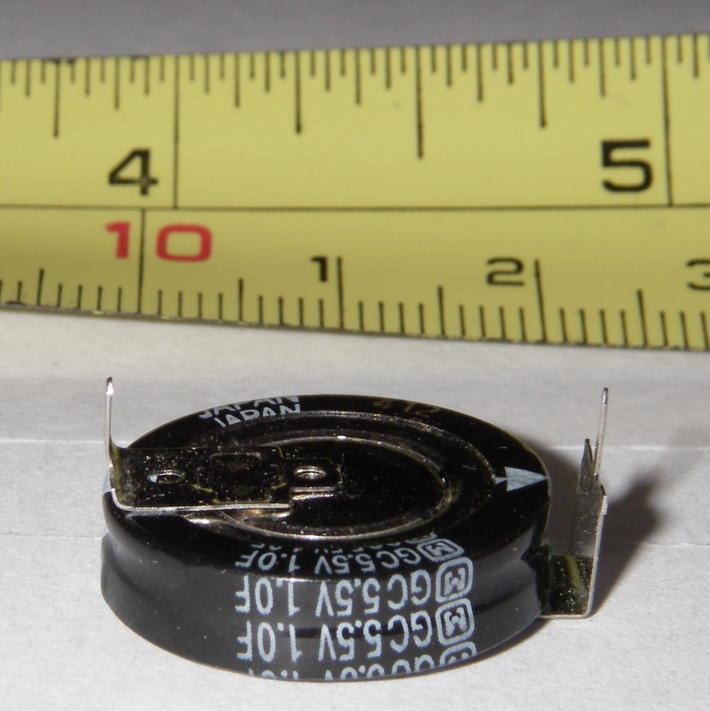Symbol F In SI base units: s⋅A⋅m⋅kg | Unit of Capacitance Named after Michael Faraday | |
 | ||
The farad (symbol: F) is the SI derived unit of electrical capacitance, the ability of a body to store an electrical charge. It is named after the English physicist Michael Faraday.
Contents
Definition
One farad is defined as the capacitance across which, when charged with one coulomb, there is a potential difference of one volt. Equally, one farad can be described as the capacitance which stores a one-coulomb charge across a potential difference of one volt.
The relationship between capacitance, charge and potential difference is linear. For example, if the potential difference across a capacitor is halved, the quantity of charge stored by that capacitor will also be halved.
For most applications, the farad is an impractically large unit of capacitance. Most electrical and electronic applications are covered by the following SI prefixes:
Equalities
A farad has the base SI representation of: s4 × A2 × m−2 × kg−1
It can further be expressed as:
where F=farad, A=ampere, V=volt, C=coulomb, J=joule, m=metre, N=newton, s=second, W=watt, kg=kilogram, Ω=ohm, H=henry.
History
The term "farad" was originally coined by Latimer Clark and Charles Bright in 1861, in honor of Michael Faraday, for a unit of quantity of charge but by 1873, the farad had become a unit of capacitance. In 1881 at the International Congress of Electricians in Paris, the name farad was officially used for the unit of electrical capacitance.
Explanation
A capacitor consists of two conducting surfaces, frequently referred to as plates, separated by an insulating layer usually referred to as a dielectric. The original capacitor was the Leyden jar developed in the 18th century. It is the accumulation of electric charge on the plates that results in capacitance. Modern capacitors are constructed using a range of manufacturing techniques and materials to provide the extraordinarily wide range of capacitance values used in electronics applications from femtofarads to farads, with maximum-voltage ratings ranging from a few volts to several kilovolts.
Values of capacitors are usually specified in farads (F), microfarads (μF), nanofarads (nF) and picofarads (pF). The millifarad is rarely used in practice (a capacitance of 4.7 mF (0.0047 F), for example, is instead written as 4700 µF), while the nanofarad is uncommon in North America. The size of commercially available capacitors ranges from around 0.1 pF to 5000F (5 kF) supercapacitors. Parasitic capacitance in high-performance integrated circuits can be measured in femtofarads (1 fF = 0.001 pF = 10−15 F), while high-performance test equipment can detect changes in capacitance on the order of tens of attofarads (1 aF = 10−18 F).
A value of 0.1 pF is about the smallest available in capacitors for general use in electronic design, since smaller ones would be dominated by the parasitic capacitances of other components, wiring or printed circuit boards. Capacitance values of 1 pF or lower can be achieved by twisting two short lengths of insulated wire together.
The capacitance of the Earth's ionosphere with respect to the ground is calculated to be about 1 F.
Informal and deprecated terminology
The picofarad is sometimes colloquially pronounced as "puff" or "pic", as in "a ten-puff capacitor". Similarly, "mic" (pronounced "mike") is sometimes used informally to signify microfarads. If the Greek letter μ is not available, the notation "uF" is often used as a substitute for "μF" in electronics literature. A "micro-microfarad" (μμF, and confusingly often mmf or MMF), an obsolete unit sometimes found in older texts, is the equivalent of a picofarad. In texts prior to 1960, and on capacitor packages even much more recently, mf or MFD rather than the modern µF frequently represented microfarads. Similarly, mmf or MMFD represented picofarads.
Related concepts
The reciprocal of capacitance is called electrical elastance, the (non-standard, non-SI) unit of which is the daraf.
CGS units
The abfarad (abbreviated abF) is an obsolete CGS unit of capacitance equal to 109 farads (1 gigafarad, GF).
The statfarad (abbreviated statF) is a rarely used CGS unit equivalent to the capacitance of a capacitor with a charge of 1 statcoulomb across a potential difference of 1 statvolt. It is 1/(10−5c2) farad, approximately 1.1126 picofarads.
